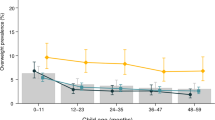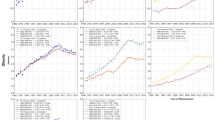Abstract
Background/Objectives
To assess longitudinal changes in the first incidence of overweight and obesity and associated factors from preschool to primary school age in Japan.
Subjects/Methods
We obtained individual-level data from the “Longitudinal Survey of Newborns in the 21st Century” on children born in Japan in 2001. This analysis included 15,427 children (7951 boys and 7476 girls) with complete anthropometric data reported annually from age 42 months to 12 years. We followed the criteria of the International Obesity Task Force to define overweight and obesity. We assessed annual and cumulative incidence proportions and estimated odds ratios for the first incidence at preschool age (42–66 months) and primary school age (7–12 years), using multivariable logistic regression.
Results
The annual incidence of overweight and obesity combined was 3.8% at age 54 months (3.5% in boys, 4.2% in girls), and 1.2% at age 12 years (1.6% in boys, 0.7% in girls). The cumulative incidence was 19.7% at age 12 years (21.9% in boys, 17.3% in girls). Odds ratios (95% confidence intervals) of incidence for girls compared with boys were 1.28 (1.12–1.46) at preschool age and 0.62 (0.55–0.68) at primary school age. Other associated factors at preschool age included birth month, birthweight, gestational length, region and municipality of residence, living with grandparents, and behavioral factors (bedtime hours, television viewing time, and skipping breakfast). These associations persisted at primary school age except birthweight and gestational length and associated factors covered maternal education, living without siblings, and school travel mode.
Conclusions
The first incidence decreases from preschool to primary school age and follows different age trajectories for boys and girls in a high-income population with low levels of childhood overweight and obesity. Policy-makers should consider such age-based changes in incidence and associated factors to target appropriate groups for primary prevention.
This is a preview of subscription content, access via your institution
Access options
Subscribe to this journal
Receive 12 print issues and online access
$259.00 per year
only $21.58 per issue
Buy this article
- Purchase on Springer Link
- Instant access to full article PDF
Prices may be subject to local taxes which are calculated during checkout


Similar content being viewed by others
References
Ng M, Fleming T, Robinson M, Thomson B, Graetz N, Margono C, et al. Global, regional, and national prevalence of overweight and obesity in children and adults during 1980–2013: a systematic analysis for the Global Burden of Disease Study 2013. Lancet. 2014;384:766–81.
NCD Risk Factor Collaboration (NCD-RisC). Worldwide trends in body-mass index, underweight, overweight, and obesity from 1975 to 2016: a pooled analysis of 2416 population-based measurement studies in 128.9 million children, adolescents, and adults. Lancet. 2017;390:2627–42.
Gunnell DJ, Frankel SJ, Nanchahal K, Peters TJ, Davey Smith G. Childhood obesity and adult cardiovascular mortality: a 57-y follow-up study based on the Boyd Orr cohort. Am J Clin Nutr. 1998;67:1111–8.
Baker JL, Olsen LW, Sorensen TI. Childhood body-mass index and the risk of coronary heart disease in adulthood. N Engl J Med. 2007;357:2329–37.
Franks PW, Hanson RL, Knowler WC, Sievers ML, Bennett PH, Looker HC. Childhood obesity, other cardiovascular risk factors, and premature death. N Engl J Med. 2010;362:485–93.
Juonala M, Magnussen CG, Berenson GS, Venn A, Burns TL, Sabin MA, et al. Childhood adiposity, adult adiposity, and cardiovascular risk factors. N Engl J Med. 2011;365:1876–85.
Batty GD, Calvin CM, Brett CE, Cukic I, Deary IJ. Childhood body weight in relation to cause-specific mortality: 67 year follow-up of participants in the 1947 Scottish Mental Survey. Med (Baltim). 2016;95:e2263.
Strauss RS, Knight J. Influence of the home environment on the development of obesity in children. Pediatrics. 1999;103:e85.
Van Cleave J, Gortmaker SL, Perrin JM. Dynamics of obesity and chronic health conditions among children and youth. JAMA. 2010;303:623–30.
Cunningham SA, Kramer MR, Narayan KM. Incidence of childhood obesity in the United States. N Engl J Med. 2014;370:403–11.
Matsushita Y, Yoshiike N, Kaneda F, Yoshita K, Takimoto H. Trends in childhood obesity in Japan over the last 25 years from the national nutrition survey. Obes Res. 2004;12:205–14.
Ministry of Education, Culture, Sports, Science, and Technology. Overview of results of the 2015 School Health Statistics. 2016. http://www.mext.go.jp/component/b_menu/other/__icsFiles/afieldfile/2015/03/27/1356103_3.pdf. Accessed 8 Sep 2016.
Ministry of Health, Labour and Welfare. Longitudinal Survey of Newborns in the 21st Century (2001 Cohort). 2015. http://www.mhlw.go.jp/english/database/db-hw/vs03.html. Accessed 28 Jun 2016.
Government of Japan. Statistics Act. 2007. http://www.soumu.go.jp/main_content/000463445.pdf. Accessed 31 Oct 2018.
Ministry of Education, Culture, Sports, Science, and Technology, Ministry of Health, Labour and Welfare. Ethical guidelines for medical and health research involving human subjects. 2014. http://www.mhlw.go.jp/file/06-Seisakujouhou-10600000-Daijinkanboukouseikagakuka/0000080278.pdf. Accessed 1 Aug 2018.
Fuse K, Nishi N, Ikeda N. Cohort Profile: 2001 Cohort of the Longitudinal Survey of Newborns in the 21st Century. Int J Epidemiol. 2017;46:1398–1398f.
Government of Japan. School Health and Safety Act. 1958. http://elaws.e-gov.go.jp/search/elawsSearch/elaws_search/lsg0500/detail?lawId=333AC0000000056. Accessed 31 Oct 2018.
Cole TJ, Bellizzi MC, Flegal KM, Dietz WH. Establishing a standard definition for child overweight and obesity worldwide: international survey. BMJ. 2000;320:1240–3.
Ueda P, Kondo N, Fujiwara T. The global economic crisis, household income and pre-adolescent overweight and underweight: a nationwide birth cohort study in Japan. Int J Obes (Lond). 2015;39:1414–20.
Lee K, Sohn H, Lee S, Lee J. Weight and BMI over 6 years in Korean children: relationships to body image and weight loss efforts. Obes Res. 2004;12:1959–66.
Sweeting HN. Gendered dimensions of obesity in childhood and adolescence. Nutr J. 2008;7:1.
Cheung PC, Cunningham SA, Naryan KM, Kramer MR. Childhood obesity incidence in the United States: a systematic review. Child Obes. 2016;12:1–11.
Hughes AR, Sherriff A, Lawlor DA, Ness AR, Reilly JJ. Incidence of obesity during childhood and adolescence in a large contemporary cohort. Prev Med. 2011;52:300–4.
von Kries R, Beyerlein A, Muller MJ, Heinrich J, Landsberg B, Bolte G, et al. Different age-specific incidence and remission rates in pre-school and primary school suggest need for targeted obesity prevention in childhood. Int J Obes (Lond). 2012;36:505–10.
Lundeen EA, Norris SA, Adair LS, Richter LM, Stein AD. Sex differences in obesity incidence: 20-year prospective cohort in South Africa. Pediatr Obes. 2016;11:75–80.
Reilly JJ, Armstrong J, Dorosty AR, Emmett PM, Ness A, Rogers I, et al. Early life risk factors for obesity in childhood: cohort study. BMJ. 2005;330:1357.
Mardones F, Villarroel L, Karzulovic L, Barja S, Arnaiz P, Taibo M, et al. Association of perinatal factors and obesity in 6- to 8-year-old Chilean children. Int J Epidemiol. 2008;37:902–10.
Franchetti Y, Ide H. Socio-demographic and lifestyle factors for child’s physical growth and adiposity rebound of Japanese children: a longitudinal study of the 21st century longitudinal survey in newborns. BMC Public Health. 2014;14:334.
Ikeda N, Fuse K, Nishi N. Changes in the effects of living with no siblings or living with grandparents on overweight and obesity in children: results from a national cohort study in Japan. PLoS One. 2017;12:e0175726.
Pala V, Lissner L, Hebestreit A, Lanfer A, Sieri S, Siani A, et al. Dietary patterns and longitudinal change in body mass in European children: a follow-up study on the IDEFICS multicenter cohort. Eur J Clin Nutr. 2013;67:1042–9.
Heilmann A, Rouxel P, Fitzsimons E, Kelly Y, Watt RG. Longitudinal associations between television in the bedroom and body fatness in a UK cohort study. Int J Obes (Lond). 2017;41:1503–9.
Kelly Y, Patalay P, Montgomery S, Sacker A. BMI development and early adolescent psychosocial well-being: UK Millennium Cohort Study. Pediatrics. 2016;138:e20160967.
Anderson SE, Sacker A, Whitaker RC, Kelly Y. Self-regulation and household routines at age three and obesity at age eleven: longitudinal analysis of the UK Millennium Cohort Study. Int J Obes (Lond). 2017;41:1459–66.
DeBoer MD, Scharf RJ, Demmer RT. Sugar-sweetened beverages and weight gain in 2- to 5-year-old children. Pediatrics. 2013;132:413–20.
Mori N, Armada F, Willcox DC. Walking to school in Japan and childhood obesity prevention: new lessons from an old policy. Am J Public Health. 2012;102:2068–73.
Lee H, Andrew M, Gebremariam A, Lumeng JC, Lee JM. Longitudinal associations between poverty and obesity from birth through adolescence. Am J Public Health. 2014;104:e70–6.
Ruiz M, Goldblatt P, Morrison J, Porta D, Forastiere F, Hryhorczuk D, et al. Impact of low maternal education on early childhood overweight and obesity in Europe. Paediatr Perinat Epidemiol. 2016;30:274–84.
Shrewsbury V, Wardle J. Socioeconomic status and adiposity in childhood: a systematic review of cross-sectional studies 1990–2005. Obes (Silver Spring). 2008;16:275–84.
Jwa SC, Fujiwara T, Kondo N. Latent protective effects of breastfeeding on late childhood overweight and obesity: a nationwide prospective study. Obes (Silver Spring). 2014;22:1527–37.
Yamakawa M, Yorifuji T, Inoue S, Kato T, Doi H. Breastfeeding and obesity among schoolchildren: a nationwide longitudinal survey in Japan. JAMA Pediatr. 2013;167:919–25.
Kuhle S, Tong OS, Woolcott CG. Association between caesarean section and childhood obesity: a systematic review and meta-analysis. Obes Rev. 2015;16:295–303.
Blustein J, Attina T, Liu M, Ryan AM, Cox LM, Blaser MJ, et al. Association of caesarean delivery with child adiposity from age 6 weeks to 15 years. Int J Obes (Lond). 2013;37:900–6.
Suzuki K, Sato M, Ando D, Kondo N, Yamagata Z. A survival analysis approach to assess the association between maternal smoking during pregnancy and childhood obesity. Nihon Koshu Eisei Zasshi. 2012;59:525–31.
Acknowledgements
This work was supported by a Health and Labor Sciences Research Grant from the Ministry of Health, Labor and Welfare of Japan (NI, grant number H27-Toukei-Ippan-005). We thank Audrey Holmes, MA, from Edanz Group (www.edanzediting.com/ac) for editing a draft of this manuscript.
Author contributions
NI and NN conceived the study. NI conducted the statistical analysis and drafted the manuscript. NN interpreted the results and revised the manuscript. NI and NN approved the final version.
Author information
Authors and Affiliations
Corresponding author
Ethics declarations
Conflict of interest
The authors declare that they have no conflict of interest.
Additional information
Publisher’s note: Springer Nature remains neutral with regard to jurisdictional claims in published maps and institutional affiliations.
Rights and permissions
About this article
Cite this article
Ikeda, N., Nishi, N. First incidence and associated factors of overweight and obesity from preschool to primary school: longitudinal analysis of a national cohort in Japan. Int J Obes 43, 751–760 (2019). https://doi.org/10.1038/s41366-018-0307-7
Received:
Revised:
Accepted:
Published:
Issue Date:
DOI: https://doi.org/10.1038/s41366-018-0307-7
This article is cited by
-
Multigenerational birth cohort study in China: importance, necessity and beyond
World Journal of Pediatrics (2023)
-
Associations of neighborhood built, safety, and social environment with walking to and from school among elementary school-aged children in Chiba, Japan
International Journal of Behavioral Nutrition and Physical Activity (2021)



